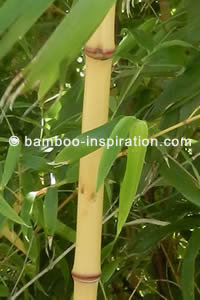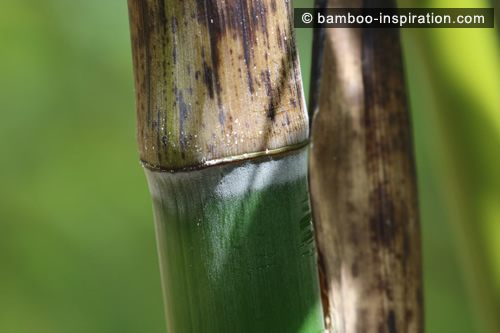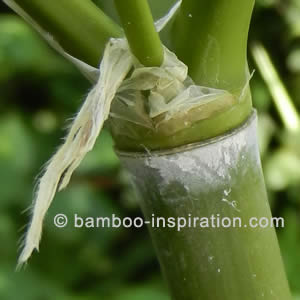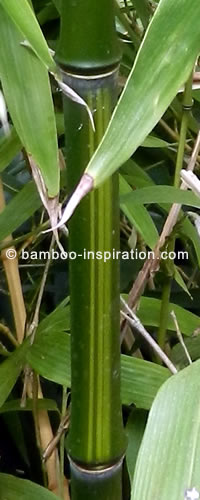- Home ›
- Bamboo Plants ›
- Phyllostachys
Phyllostachys
Bamboos in the Phyllostachys genus are brilliant for gardens, a wide variety to choose from with excellent versatility from evergreen boundary screening to ornamental specimens.
Tall, majestic, bold colours that change over time, stripes (indented groove/sulcis), zig zag culms, it can be hard to choose and, once addicted, people often end up collecting these giant bamboos.
Phyllostachys Hardiness
This genus Phyllostachys has some of the hardiest bamboo suitable for more northerly climates and gardens with harsher winters.
Many have been successfully located in cooler climates than their original native countries and have been proven to be tolerant of cold conditions. This is not to say that they will not tolerate warmer conditions as well as many Phyllostachys species will not only put up with the deep cold of winter, they will also tolerate hot summers.
Some species are said to be hardy down to -25C (-13F), that’s pretty cold and tolerance would have to have been measured over some years to be sure. If you live in an extremely cold climate it may be best to buy from a nursery that is actually in the same climate and has been producing plants in those temperatures successfully.
A Phyllostachys hardiness range from -15C (5F) to -25C (0F) gives you an idea that you must make your choice carefully; don’t assume all species tolerate the lowest temperatures.
Exact hardiness details will be included with the individual species. It all depends on the native habitat of the original bamboo, for example whether the species was discovered in cold mountains or warmer lowlands. Bamboo in Winter
Phyllostachys list further down page.
Growth, Height, and Spread
If you are looking for a hardy bamboo to achieve a good height in a temperate garden, Phyllostachys will be what you are looking for.
The climate can play a part in whether Phyllostachys will form into a clumped bamboo or will spread vigorously. For example, in ideal condition a plant may spread aggressively, whereas in a cooler climate it may remain in a tight clump.
Shooting
One interesting and ultimately exciting aspect of Phyllostachys is watching their shoots appear through the growing period. As the plants mature the shoots get bigger, often appear in one colour and changing to another as the culm matures. Different species shoot at different times, the more cold tolerant from mountainous regions tending to shoot earlier in the year. Some shoots are edible, but again check first as some may be toxic.

When bamboo shoots appear where they are not supposed to they can simply be snapped off to control spreading. The plant is not likely to spread fairly mature and therefore it may not be a concern for a couple of years or so. Check with the individual species proven growth habit, clumped or runners.
Planting Space
Give your Phyllostachys plenty of room even if it is a clumping variety because the established clumps can still get pretty big over ten years. Make sure you cater for the width at the top as well as at the bottom. The leaves and branches will make the whole planting wider.
When choosing the location for planting, try to visualise the bamboo at full height, where the sun goes round, where shadows will fall, which way the wind comes from, does the species prefer shade, sun, or part shade. All these variations will help you decide the best planting spot.
Uses of Phyllostachys Bamboos
The culms of Phyllostachys have a woody structure and therefore are utilised commercially for products, crafts, poles and canes.
In the garden, they can be planted for screens and hedging, as big solitary specimen plants, in a row... usually an odd number looks better than an even number, which is why hedging is should really be bought as an odd number unless it’s a long hedge. If you can visualise a row of three plants against a fence or wall, it looks much better than two or four. I’m not really sure why, it just seems that way! They can be kept in big pots but, as with all potted plants, will need additional care, watering, fertiliser etc.
Phyllostachys List
Here is a list for the genus Phyllostachys but note that I am not listing everything here and within some of these there are more varieties.
Phyllostachys acuta
Phyllostachys angusta
Phyllostachys arcana
Phyllostachys atrovaginata
Phyllostachys aurea (Golden)
Phyllostachys aurea Holochrysa
Phyllostachys aurea Koi
Phyllostachys aureosulcata
Phyllostachys aureosulcata f. aureocaulis
Phyllostachys aureosulcata Harbin
Phyllostachys aureosulcata f. spectabilis
Phyllostachys bambusoides
Phyllostachys bambusoides Allgold
Phyllostachys bambusoides Castillonis
Phyllostachys bissetii
Phyllostachys dulcis
Phyllostachys edulis
Phyllostachys elegans
Phyllostachys flexuosa
Phyllostachys glauca
Phyllostachys guizhouensis
Phyllostachys heteroclada
Phyllostachys humilis
Phyllostachys incarnata
Phyllostachys iridescens
Phyllostachys kwangsiensis
Phyllostachys makinoi
Phyllostachys mannii
Phyllostachys meyeri
Phyllostachys nidularia
Phyllostachys nigella
Phyllostachys nigra (Black)
Phyllostachys nigra Boryana
Phyllostachys nigra Fulva
Phyllostachys nigra f. henonis
Phyllostachys nuda
Phyllostachys parvifolia (Green)
Phyllostachys prominens
Phyllostachys propinqua
Phyllostachys rivalis
Phyllostachys rubromarginata
Phyllostachys sulphurea
Phyllostachys tianmuensis
Phyllostachys violascens
Phyllostachys viridiglaucescens
Phyllostachys vivax (Green and Yellow)
Phyllostachys vivax f. Aureocaulis
Phyllostachys vivax huanvenzhu
Phyllostachys vivax f. huanvenzhu
Phyllostachys vivax f. huanvenzhu inversa
Phyllostachys yunhoensis


